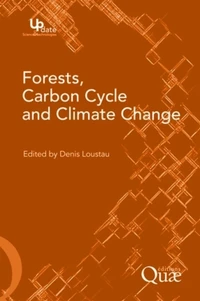Forests, Carbon Cycles and Climate Change
Par :Formats :
Disponible dans votre compte client Decitre ou Furet du Nord dès validation de votre commande. Le format Multi-format est :
- Pour les liseuses autres que Vivlio, vous devez utiliser le logiciel Adobe Digital Edition. Non compatible avec la lecture sur les liseuses Kindle, Remarkable et Sony
 , qui est-ce ?
, qui est-ce ?Notre partenaire de plateforme de lecture numérique où vous retrouverez l'ensemble de vos ebooks gratuitement
Pour en savoir plus sur nos ebooks, consultez notre aide en ligne ici
- Nombre de pages348
- FormatMulti-format
- ISBN978-2-7592-0989-7
- EAN9782759209897
- Date de parution04/03/2010
- Protection num.NC
- Infos supplémentairesMulti-format incluant ePub sans ...
- ÉditeurQuae
Résumé
The results presented in this book summarize the main findings of the CARBOFOR project, which brought together 52 scientists from 14 research units to investigate the effects of future climate on the carbon cycle, the productivity and vulnerability of French forests. This book explains the current forest carbon cycle in temperate and Mediterranean climates, including the dynamics of soil carbon and the total carbon stock of French forests, based on forest inventories.
It reviews and illustrates the main ground-based methods for estimating carbon stocks in tree biomass. Spatial variations in projected climate change over metropolitan France throughout the 21st century are described. The book then goes on to consider the impacts of climate change on tree phenology and forest carbon balance, evapotranspiration and production as well as their first order interaction with forest management alternatives.
The impact of climate change on forest vulnerability is analysed. A similar simulation study was carried out for a range of pathogenic fungi, emphasizing the importance of both warming and precipitation changes. The consequences of climate change on the occurrence of forest fires and the forest carbon cycle in the Mediterranean zone are also considered. A valuable reference for researchers and academics, forest engineers and managers, and graduate level students in forest ecology, ecological modelling and forestry.
It reviews and illustrates the main ground-based methods for estimating carbon stocks in tree biomass. Spatial variations in projected climate change over metropolitan France throughout the 21st century are described. The book then goes on to consider the impacts of climate change on tree phenology and forest carbon balance, evapotranspiration and production as well as their first order interaction with forest management alternatives.
The impact of climate change on forest vulnerability is analysed. A similar simulation study was carried out for a range of pathogenic fungi, emphasizing the importance of both warming and precipitation changes. The consequences of climate change on the occurrence of forest fires and the forest carbon cycle in the Mediterranean zone are also considered. A valuable reference for researchers and academics, forest engineers and managers, and graduate level students in forest ecology, ecological modelling and forestry.
The results presented in this book summarize the main findings of the CARBOFOR project, which brought together 52 scientists from 14 research units to investigate the effects of future climate on the carbon cycle, the productivity and vulnerability of French forests. This book explains the current forest carbon cycle in temperate and Mediterranean climates, including the dynamics of soil carbon and the total carbon stock of French forests, based on forest inventories.
It reviews and illustrates the main ground-based methods for estimating carbon stocks in tree biomass. Spatial variations in projected climate change over metropolitan France throughout the 21st century are described. The book then goes on to consider the impacts of climate change on tree phenology and forest carbon balance, evapotranspiration and production as well as their first order interaction with forest management alternatives.
The impact of climate change on forest vulnerability is analysed. A similar simulation study was carried out for a range of pathogenic fungi, emphasizing the importance of both warming and precipitation changes. The consequences of climate change on the occurrence of forest fires and the forest carbon cycle in the Mediterranean zone are also considered. A valuable reference for researchers and academics, forest engineers and managers, and graduate level students in forest ecology, ecological modelling and forestry.
It reviews and illustrates the main ground-based methods for estimating carbon stocks in tree biomass. Spatial variations in projected climate change over metropolitan France throughout the 21st century are described. The book then goes on to consider the impacts of climate change on tree phenology and forest carbon balance, evapotranspiration and production as well as their first order interaction with forest management alternatives.
The impact of climate change on forest vulnerability is analysed. A similar simulation study was carried out for a range of pathogenic fungi, emphasizing the importance of both warming and precipitation changes. The consequences of climate change on the occurrence of forest fires and the forest carbon cycle in the Mediterranean zone are also considered. A valuable reference for researchers and academics, forest engineers and managers, and graduate level students in forest ecology, ecological modelling and forestry.




